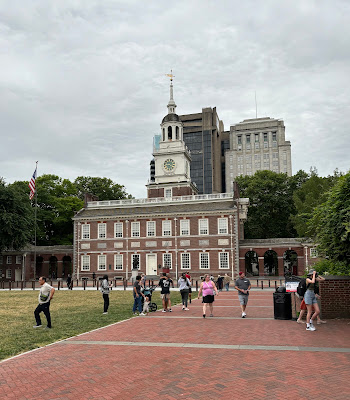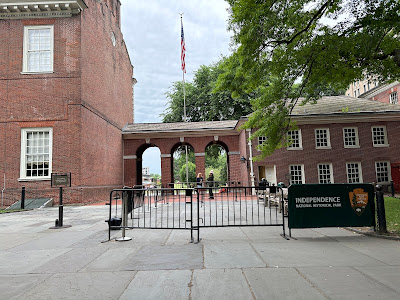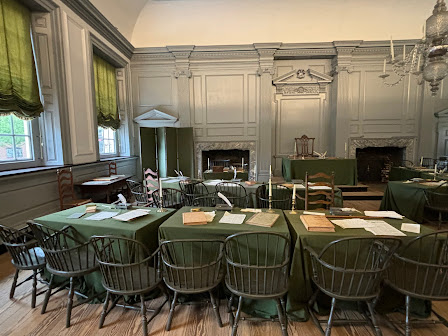The next day (Sunday) we made arrangements to go to downtown Philadelphia. We try to visit big cities on the weekend so traffic and parking is easier.
We had tickets to visit Independence Hall but as we'd driven by the day before, we noticed that there was a long line to see the Liberty Bell so we went there first.
We realized that the long line was due to backups with security and even though there wasn't much of a line, it still took awhile to get through it. It wasn't the most efficient security I've ever seen.
And there it was!
The Liberty Bell was previously called the State House Bell or Old State House Bell. It was originally placed in the steeple of Pennsylvania State House, now known as Independence Hall, and is now located across the street in the Liberty Bell Center.
The bell was commissioned in 1752 by the Pennsylvania Provincial Assembly from the London-based firm Lester and Pack, later renamed the Whitechapel Bell Foundry, and was cast with the lettering "Proclaim LIBERTY Throughout all the Land unto all the inhabitants Thereof", a biblical reference. The bell first cracked when rung after its arrival in Philadelphia, and was twice recast by local workmen John Pass and John Stow, whose last names appear on the bell. In early years, the bell was used to summon lawmakers to legislative sessions and to alert citizens about public meetings and proclamations.
After World War II, Philadelphia allowed the National Park Service to take custody of the bell, while retaining ownership. The bell was used as a symbol of freedom during the Cold War and was a popular site for protests in the 1960s. It was moved from its longtime home in Independence Hall to a nearby glass pavilion on Independence Mall in 1976, and then to the larger Liberty Bell Center adjacent to the pavilion in 2003 where it remains today.
It was time to go across the street for our tour time.
We made it through security (much more efficient this time) and waited for our scheduled tour.
The construction of Independence Hall, initially called the Pennsylvania State House, was completed in 1753. It served as the first capitol of both the colonial-era of the Province of Pennsylvania and, following American independence, the nation's first capital and the capital of Pennsylvania.
We met our guide, Suzanne, and we went inside to the courtroom.
Suzanne standing in the prisoner's dock
The Supreme Court of Pennsylvania heard their cases in this room beginning around 1743. The courtroom contained a judges' bench, jury boxes, prisoner's dock, and a table for the lawyers. Other courts later used this room, and it even served as a museum in the late 1800s.
Notice the Pennsylvania Coat of Arms above the judges' bench which was placed there in 1785. This symbol replaced an earlier one - the Coat of arms of King George III of Great Britain. On July 8, 1776, members of the Pennsylvania Associators removed the symbol of the King from the wall and later destroyed it.
The Declaration of Independence and the United States Constitution were both signed in this room across the hall, the Assembly Room. Later, the room became a shrine to the founding of the nation, proudly displaying the Liberty Ball and original paintings of the Founding Fathers. That was the scene when President-elect Abraham Lincoln visited the Assembly Room and praised the ideals expressed in the Declaration of Independence. Following his assassination, Lincoln's body lay in repose here for two days.
Notice the chair at the front of the room.
George Washington used this chair for nearly three months of the Constitutional Convention's continuous sessions. Benjamin Franklin is credited with immortalizing the chair at the close of the convention, observing:
"I have often looked at that picture behind the president without being able to tell whether it was rising or setting. But now at length I have the happiness to know that it is a rising and not a setting sun."
Some interesting facts about Independence Hall.
- The basement once served as the city's dog pound
- The second floor was once home to Charles Willson Peale's museum of natural history
- Some historians note that Benjamin Franklin would occasionally trip other delegates from his aisle seat
- George Washington, knowing that his opinion would carry undue weight, contributed little to the debate over the Constitution
- Even though the days were very hot in the summer of 1787, windows were kept closed so others could not overhear their discussions
With the tour over, we went outside and joined a tour of Congress Hall which is conjoined with Independence Hall. The hall served as the seat of the United States Congress from December 6, 1790 to May 14, 1800. During Congress Hall's duration as the capitol of the United States, the country admitted three new states, Vermont, Kentucky, and Tennessee; ratified the Bill of Rights of the Constitution; and oversaw the presidential inaugurations of both George Washington (his second) and John Adams.
Quinn
Philadelphia served as the capital of the United States both during and immediately after the Revolutionary War. Independence Hall served as the meeting place of the Continental Congress until the Pennsylvania Mutiny in June, 1783. The failure of the Pennsylvania government to protect Congress from a mob of angry mutineers caused the representatives to withdraw to Princeton, New Jersey. The national capital then moved to Annapolis, Maryland in November, 1783, then to Trenton New Jersey in November, 1784 before finally moving to New York City in January, 1785. State delegates did not return to Independence Hall until the United States Constitutional Convention in 1787; however, New York City remained the official capital even during the convention.
In the 20th century, Congress Hall was restored to its original appearance in 1796.
The House chamber on the first floor is simple and featured mahogany desks and leather chairs. The room eventually accommodated 106 representatives from 16 states: the 13 original states as well as representatives from the new states of Vermont (1791), Kentucky (1792), and Tennessee (1796).
The second floor, reserved as the chamber for the Senate, was more ornate and adorned with heavy red drapes. By 1796, the room featured 32 secretary desks very similar to the desks that are still used in the current State chamber in the United States Capitol; 28 of the desks at Congress Hall are original. The carpet seen today is a reproduction of the original.
Committee Room
Conference Room
Office
The day was only half over and we still had much to see so off we went to explore some more areas of interest in the city.




















Many of my ancestors once lived in Philadelphia, and my dad was born and raised there. But I barely know it! Did you go to the American Jewish history museum there? We did some years ago on a genealogy research trip.
ReplyDeleteWe went BY the museum but didn't go in. We also saw Congregation Mikveh Israel, the oldest continuing living congregation in America founded in 1740.
DeleteYes, some of my ancestors belonged to that synagogue.
DeleteThere was a sculpture and a plaque nearby of Uriah Phillips Levy - you know that caught my attention :-)
Delete